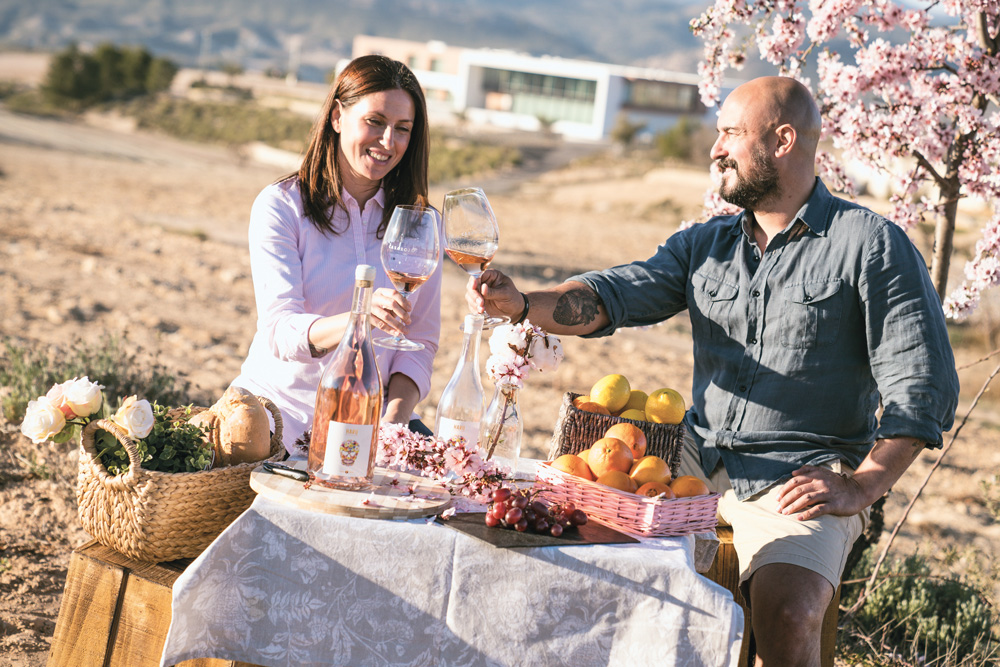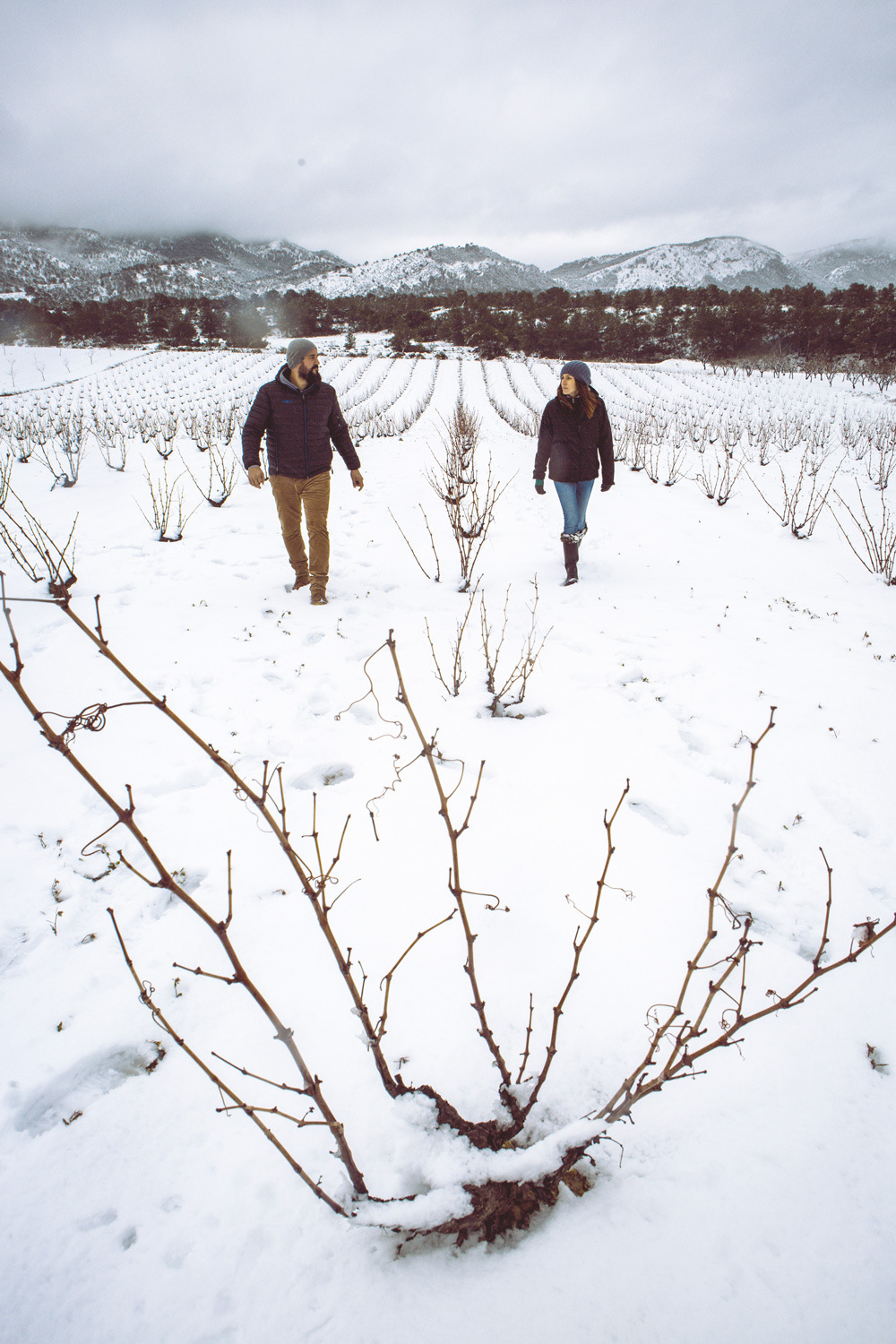With an eye for storytelling, Casa Rojo’s founders have blazed a trail for a new style of winemaking in Spain.

It’s not often that wine labels look like movie posters, but on top of that, José Luis Gomez looks like he stepped right out of his MachoMan bottle. Which is indeed accurate, as the label was based on a caricature of Gomez by Spanish artist Eduardo del Fraile, a good friend.
Gomez, 44, and his wife Laura Muñoz, 37, are an attractive winemaking couple. They are unabashedly plugged into social media and millennial drinking culture and share many of the same values and interests of that generation. As Gomez articulates, “The future is here, so you have to adapt or die. The new generation of wine drinkers is interested in holistic quality, not just the product. They want to know the approach all the way to the moment of consumption.” He chuckles as he checks my Instagram photos, reminding me to tag Casa Rojo in order to reach their avid followers.

Born in wine
Muñoz was born into a winemaking family, waking up to the smells of fermentation and watching her father stomp grapes while Gomez got started in the wine business at 18 years old. They met in Japan on separate business missions, and had an immediate connection over drinks at a Roppongi bar. If the movie Lost in Translation comes to mind, that’s a resemblance that has occurred to Muñoz as well.
Married in 2008, they started Casa Rojo in 2010 with the ambition of elaborating the best wines across different regions across Spain and native grapes to faithfully represent the terroir of each. It resembles a négociant business, which, while well-established in France, is relatively rare in Spain. Today, they handle nine different projects across Spain – MachoMan (Monastrell) from D.O. Jumilla, El Gordo del Circo from D.O. Rueda, The Orange Republic (Godello) from D.O Valdeorras, La Marimorena (Albariño) from D.O. Rias Baixas, Ladrón (Mencia) from D.O. Bierzo, Alexander vs The Ham Factory (Tinta Fina) from D.O. Ribera del Duero, Maquinón (Garnacha Negra) from Priorat, The Invisible Man (Tempranillo) from D.O Rioja, and Molto Negre (Trepat) a D.O. Cava from Villafranca del Penedés.
If the list reads like a Spanish guide to grapes and regions, that is no coincidence. Says Gomez, “Wines have to tell you a story. As enologists, we have to respect what those grapes want to tell you, what they smell like, what they taste like. Respecting and interpreting the terroir is the base of a great wine.” Like many winemkers, Gomez looks up to the legendary Dane, Peter Sisseck whose philosophy and Dominio de Pingus Ribera del Duero wines propelled Spanish wines to the world’s attention.
Like Sisseck, Gomez pays attention to the native materials. “Grapes are life forms that have been adapting to their surroundings for centuries. My vision is that we have to work those grapes, make wines with those grapes that have adapted to that area for many centuries,” he says. Every year, they strive to make the wines better – whether through pruning innovation for higher concentration, low and very controlled fermentation temperatures, low maceration, or choosing extraordinarily mild oak for their French barriques. The quest never ends to find the best grapes, the best winemakers, and people with local knowledge.
The best part of working together, the couple agrees, is that learning goes at double the speed. They are as likely to be pairing MachoMan with arroz con conejo y caracoles (traditional paella with rabbits and snails) as they are dreaming up the next label for Minami, a small production of Monastrell slated for release this year with just 8,000 bottles. Though more blockbuster grapes such as Tempranillo in Rioja sell better, they feel strongly for Monastrell (a.ka. Mouvedre or Mataro) and its potential. As Gomez sums up, “We will continue to make and push what we are and believe.”

MOLTO NEGRE
Grapes: 100% Trepat
Taste: Made in traditional method, this extra brut Cava has just 3.5g/litre of sugar, accentuating its bright Trepat fruit and crisp acidity. Only the first press juice is used, giving the wine its aromatic bloom and fresh nose. This ‘black sheep’ of sparkling Cava pairs well with pizza, pasta and poolside parties. $60
ALEXANDER VS THE HAM FACTORY 2015
Grapes: Tinta Fina, Cabernet Sauvignon, Malbec, Merlot
Taste: From the Ribero del Duero comes an iconic collaboration with the Miguel Sanz family, specialist in Bordeaux and Tempranillo varieties. Small yields and higher concentration allow the grapes to express intensity of black fruit compote, with notes of mocha and vanilla. $98
MACHOMAN 2016
Grapes: 100% Monastrell
Taste: A passion project to revive Monastrell from the D.O.Jumilla, this signature bottle is aged in new French oak as well as 800-litre Roman clay amphoras. The terroir imbues the dark wine with ample red plum and cherry flavours, tinged with thyme and balsamic, making it ideal with Mediterranean dishes. $69